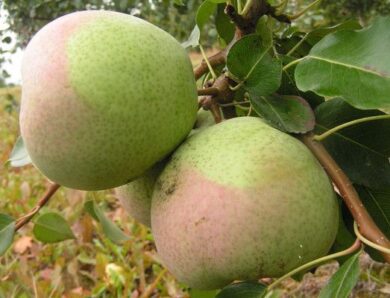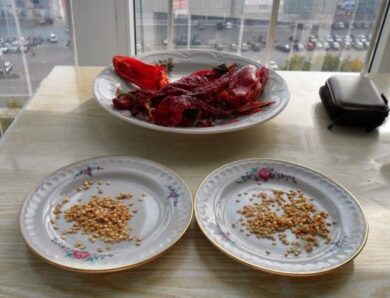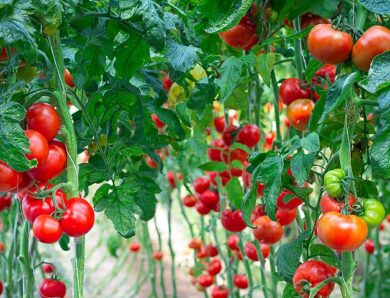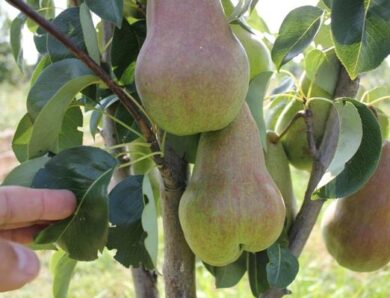How to tie raspberries correctly: different ways
Many people prefer to grow different varieties of raspberries in their gardens. This is a very tasty and useful berry crop, which also has not very complicated care. One of the most important aspects of growing raspberry bushes is their garter. This article will tell you about it, why you need a raspberry garter, and how it can be done.
What is it for?
To achieve a good harvest from raspberries, you need to know some features of caring for him. One of the essential rules of success here is garter bushes. If this procedure is not performed, then the risk of getting small and tasteless berries increases. So you need to know, how to tie raspberries properly.
Of course, tying is not always a necessary condition for abundant fruiting. There are varieties, who do not need it. However, the vast majority of yellow and red raspberries still require a tying procedure. The reason for this need lies in the presence of fragile and flexible shoots, which can break in the following situations:
- with strong and gusty winds;
- during prolonged rains;
- with abundant fruiting;
- at sufficient height of bushes. Some varieties of raspberries are able to grow up 2 m, or even higher.
In addition to protecting raspberries from physical damage, the garter can simplify the harvest to some extent. With its help you can arrange randomly growing and prickly shoots. But the most important reason, on which the garter of raspberry bushes is made, there is an increase in yield. The point is, that for ripening of sweet and big fruits branches should be well lighted.
In itself, raspberries are considered quite unpretentious plant. However, in case of non-compliance with certain rules of care, including garters, it can give a lot of young growth and savagery. Therefore, one of the important and necessary aspects of its care is the tying procedure. The gardener gets the following benefits when it comes to gargling raspberry bushes:
- protection of plants from various fungal infections, as well as pests;
- fruitful young shoots, growing in the middle of the row, get more favorable conditions for their growth. It is worth noting, that with dense planting of bushes, who found themselves in the thick of it, die very quickly;
- shoots do not break under the weight of the crop, as well as in adverse climatic conditions;
- berries on the branches are tied and ripen much faster. At the same time their maturation is characterized by greater uniformity, as fruits in this case receive the same portion of sunlight;
- harvesting becomes more convenient and less traumatic (this statement is especially true of varieties, which are characterized by the formation of a large number of spines).
If the raspberry garter was done correctly, then all the above benefits will be available and from one bush you can collect the maximum amount of harvest.
Video "Garter on the wallpaper"
You will learn from the video, how to make wallpaper and tie a bush.
garter methods
Many novice gardeners often wonder "how to tie raspberries". This is a topical issue, as there are several options for gartering raspberry bushes today:
- circular way. Here is a bunch of stems, consisting of 6-7 shoots, must be fixed at a height of one and a half meters. You need to tie the stems to a two-meter circle, which is located in the center of the beam. The top of the high escape should be bent in an arc and also fastened to the support;
- fan method. In this case, between the bushes you need to place pegs. Only half of the bush is tied to the killed circle on each side. As a result, on the right side of the circle is half of the shoots of one bush, and on the left - a neighboring plant. The height of the hammered stakes should be approximately 2 m. As a result, after the garter, raspberry shoots resemble a fan, which gave the name to this method of garter. The advantage of the fan method is to improve access of air and light to the young, vertically growing stems. Despite this, this method is rarely used in gardens;
- wallpaper method. Here you can use a variety of designs as a support, which are columns with a wire stretched between them.
The most common of the above methods is the circular method. It is easy to implement, does not require much time for the organization, as well as quite economical. Most often it is used for small in size Malinnikov. Wooden pegs in the implementation of this method of tying can be replaced by reinforced concrete poles or metal pipes. However, despite its advantages, this method has the following disadvantages:
- shoots are illuminated unevenly;
- inside the bush after garter ovaries begin to develop more slowly;
- protection of branches from breakage is insufficient;
- there is a risk of various diseases and pests in dense plantings.
Many gardeners have recently become more likely to prefer non-stakes, and wallpaper on how to tie raspberries.
Types of wallpaper garter
To date, the most progressive and modern way to care for the bushes is a garter on the wallpaper raspberries. It is used in large gardens, in which plants are planted in rows. This garter allows you to evenly illuminate the bushes, as well as protection of branches from strong winds. With, if such a method was implemented correctly, then harvesting and protecting plantings from pests will be much easier. The main advantage of the wallpaper method of garter raspberries is to double its yield.
It is worth noting, that you can tie raspberries to wallpaper in different ways. Consider each option in more detail.
single
With a single trellis garter, the wire should be stretched between the posts. It is stretched on three levels: 165, 105 and 75 cm from the ground.
The technology of placement of supports is as follows:
- pillars (2 meters and above) you need to dig into the ground for half a meter;
- supports should be placed at a distance 4 meters from each other;
- first you need to dig pillars with supports, and then carry out the installation of other supports;
- three rows of wire are tightened and fixed with special clamps and bolts.
Construction, characterized by compactness. Therefore, it can be placed in small gardens. The main feature of this method is tying each stem of the plant separately. As a result, they are well lit and have protection from the wind. The disadvantage of this approach is the risk of breaking branches during harvest. However, this situation is possible only in the absence of a garter to the bottom row.
double
With a double wallpaper garter sets two half-meter crossbars. Further, the wire should be stretched at their ends, the lower edge of which should be above the ground at a distance 0,9 meters, and the top - 1,5 meters. This design, in contrast to a single allows you to place on the same area many times more shoots and, in accordance, gather a bountiful harvest. However, such a structure somewhat complicates the harvesting procedure. The risk of breakage of shoots remains quite high.
Scandinavian
Another option for a wallpaper garter is the Scandinavian method. It involves stretching the wire on a one-meter crossbar, which is located a meter from the ground. At the same time installation of paired columns is necessary.
Their height should be up to one and a half meters. They should be dug into the ground for half a meter. The distance between them should be one meter.
The same interval is maintained for adjacent pairs of supports. As a result, when flying over such structures, raspberry shoots acquire V- similar profile.
movable turnstile
The wall-paper method of a garter on type of a movable turnstile is rather difficult in terms of realization. It allows you to change the position of the supports from vertical to horizontal. The design allows you to change the angle of the crossbar 120 degrees. At the same time it will be fixed shoots. The design of this plan allows you to quickly and comfortably remove the fruit from the bushes. The stems are well lit., which is a good help for a bountiful harvest.
Growing without a garter
Some varieties of red and yellow raspberries can be grown without a garter. But this method of cultivation is suitable only for upright varieties, which are characterized by thick shoots and grow to a height of not more than 1,5-1,8 meters. Such varieties include Bulgarian Ruby, Spirina is white, Shy, Corals, Balm and others.
The cultivation of such species is as follows:
- in the first year there are offspring do not touch. As a result, a solid band is formed, consisting of shoots, which can reach a width 50-70 cm;
- next year all the stems, extending beyond this band, removed. It is worth noting, that here it is necessary to avoid excessive internal condensation. Therefore, thinning is carried out, at which the distance between adjacent shoots is approximately 20 cm.
If you follow these recommendations, then you can get a fairly high yield. In all other cases, a raspberry garter is a must.
Video "Raspberry Bush Garter"
You will learn from the video, how to make a garter bush with berries.




